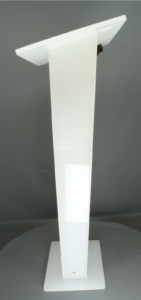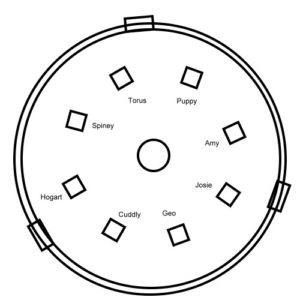Writing Memes
Something To Do When You’re Stuck
When I’m stuck somewhere waiting, like in a queue, for a lift, or even at a walk sign, I might fill in those wasted seconds by checking out some memes on ImgFlip
There are a number of memes sites out there, and each caters for a particular crowd or has features that appeal to certain groups. I’ve tried a few, but Imgflip seems to be closer to the site I’d prefer to hang out at.
One of the features I love at this site is their template library, as well as the ease of creating a meme and posting it within a minute. If I’m sitting waiting for my tram to get to a destination, and have a thought that I want to share, I can call up a template, type a few words, and have it posted within a minute, all from a mobile, tablet or netbook.
Online Research
With one of my previous books, I had to research some medical statistics to make sure that the death I had planned for a character would be logical – bumps on the head not causing concussion notwithstanding. This would lead me, as random links generally do, into the warren of associated links and diseases and murders and…
After immersing myself in general mayhem and destruction until I found the information I wanted, and realising it wouldn’t work, I suddenly became aware of my internet history. If someone was to stumble onto all those pages of invasive medical procedures, what would they think?!
And so, I grabbed this template off imgflip and created this meme:
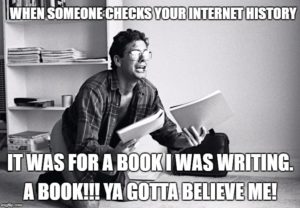
Great Minds Think Alike
When I was writing my novel last year, I was also excitedly waiting for both Star Trek: Discovery and The Orville. I made sure to finish my book before they were screened, so that anything I wrote wouldn’t be influenced by them. (There was no way I could avoid spoilers!)
My mystery story Alien Frequency, set against a binary star system in a ship that could materialize anywhere in the galaxy, I was sure would be fairly original. I also thought having a crew of slightly amusing aliens would bring humour back to an overly serious genre. There was even written an introductory scene featuring Captain Hogart introducing his crew one by one and making jokes. Pretty sure that hadn’t been done either. I was hopeful people would love my character Amy who was a greenish blob most of the time, but liked to slide around in a feminine form. (She is a reimagined version of my Alien Bob character who worked as a plant engineer on the intergalactic starship The Celestial Breeze in my ‘Alien Characters‘ series.)
You have no idea how surprised I was to find Star Trek: Discovery’s first episode was set in a binary star system. I was further surprised to find that the ship could rematerialise anywhere in the galaxy. In The Orville, I knew it was going to be fairly amusing too, a bit like Red Dwarf, but I was surprised to find that the first episode of The Orville featured the captain introducing his crew one by one. Not to mention a blobby alien character very similar to my characters Alien Bob / Amy.
I later found there were a lot of other similarities between both shows, my book and even some of my previous stories, as well as some I had working drafts for that I hadn’t released yet.
I couldn’t believe it.
There must be a collective consciousness of SF wants somewhere, and I must have tapped into it along with these writers. In any case, after lifting my head from my hands, I created this meme:
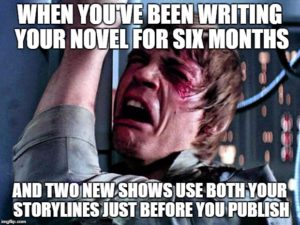
Getting Back Into the Right Headspace
I took a few months off from writing after that and focused on other things. I was so disappointed by the situation.
After finally breaking through this selfish reflective period, I got started on my next novel.
The Andromeda Effect was going to be bold, with most of it set in another galaxy, 2.5 million years ago. It was going to have time line problems, multiple characters and motives, and be light on description and rich in dialogue. I wanted it to be daring, original, and fun to write.
I set to work first with some introductory paragraphs on my set piece Space Station X-1a, orbiting Saturn.
Ingredients Needed
But starting off with a meeting was boring, so I decided to add some danger. Keep people reading but not have the pages more exciting than what was to come? What could be dangerous but not deadly? Cause enough problems for the station without actually destroying it. Space weather? What could that be?
I know. I’ll use gravity waves. No one’s done that. Let’s have an exciting first few pages with gravity waves striking the station, and all the humans and aliens running about trying to save it and themselves. How exciting!
What?
4 months after writing that (you can see the draft I put online here – Excerpt from The Andromeda Effect) I stumbled across a second hand copy of Peter F. Hamilton’s The Temporal Void. Of course, as it had the word ‘temporal’ in the title, it caught my eye, and I sat down to read the first couple of pages.
Wait! What? What’s this? A station being hit by gravity waves in the first few pages? Humans and aliens running about?
Noooooooo!
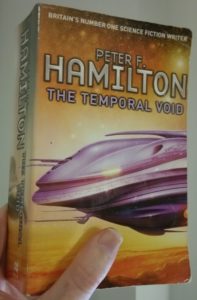
I wonder how many other books have gravity waves striking space stations at the beginning of them.
Peter’s book is now sitting on my book pile waiting until I finish writing my novel. (It was just a $1. I couldn’t pass it up, even though I haven’t read vol 1 yet. Thank you Red Cross.)
Not Stopping Again
This time, I’m going to soldier on. If I stop writing because someone else has done something similar, I’ll never write!
But, I’ll probably need some fortification to keep me going. And so, I grabbed another imgflip template and created this meme:
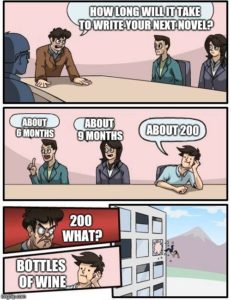
Now, all I need to do is scrape together enough for another $3 bottle of wine to continue!
